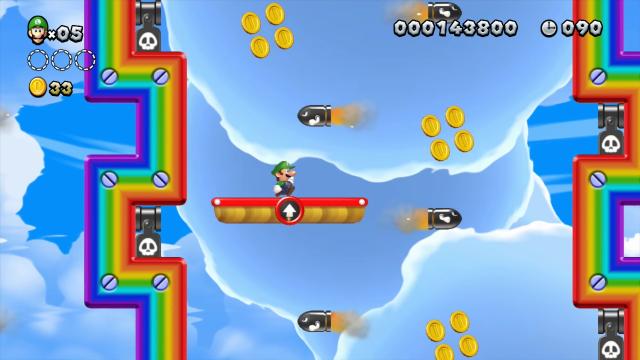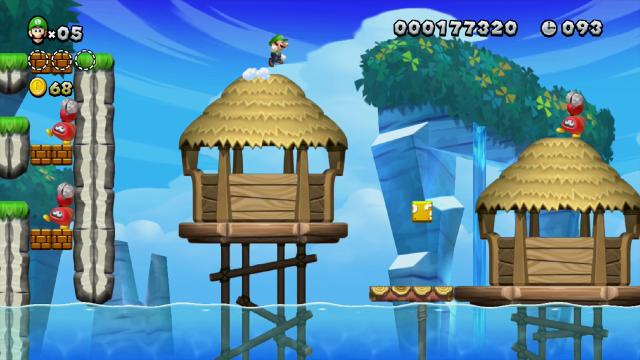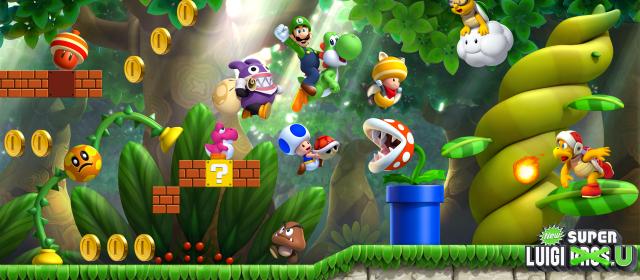If Mario is Bruce Springsteen, then Luigi is Bob Marley. Mario’s style is punchy and precise, educated gymnastic precision fitting nicely into tightly-designed stages. But Luigi is less rehearsed and more improvisational; his slippery shoes and heightened jump lend him a peppy, flops-y air as he topples around his games’ less mathematical stages with seemingly accidental grace. Luigi is no less manageable in his style, he’s just got his own tempo, and it’s his brand of syncopated bouncing that dictates the design of this remix DLC.
New Super Luigi U is DLC for New Super Mario Bros U that re-designs every level from the original game. The levels stick to the same core idea, but all the challenges are re-thunk while new elements are introduced within them, ranging from the simply visual sort to completely new platforms. What this does mean is that for your money you’re essentially getting the whole game, including star road and all those hidden star coins, completely refreshed; a lot of game.
So why call it a ‘remix’? Because the re-designed levels and the way Luigi controls are the only genuine changes. Well ok, there’s also Nabbit added as character number four due to Mario’s vacancy – he acts as a ‘novice’ character in that he doesn’t take damage from hazards which makes him great for younger players – but we’ll talk more about that in a minute.
Outside of the stages everything is familiar. The world map is the same, the paths you take are the same, the narrative setup is the same, the toad-house mini-games are the same, and there are no new challenges or boost-rush stages (you also can’t attempt any part of the original game with Luigi’s physics, which is a real shame). Even inside the levels you’ve got the same bosses rearing their heads at the same points – though it does feel wonderfully cheeky to beat a few bosses earlier, or easier, by employing Luigi’s boosted jumping abilities.
So what we have is not an expansion in the typical sense, but instead a re-interpretation of New Super Mario Bros U with the lanky brother’s gambol leading the design. A meaner, tighter re-jig, but also one that likes to have a chuckle every now and again.
Difficulty is a driving trait of New Super Luigi U’s design. These stages are made to test you, with far more aggressive hazards rearing their head almost immediately and less of an emphasis on power-ups (Yoshi and his babes are almost entirely absent), alongside a shorter 100 second time limit for every level. These levels are shorter, however, meaning that the time limit is never quite as severe as it sounds. You’ll frequently have 50 seconds or more still on the clock if you just run through a stage. Having the full 400 seconds would have felt gratuitous.

The hazards are largely brilliant. From navigating a series of churning underground pillars or luring an Ice Bro into turning a line of Fuzzys into platforms, to avoiding a piranha plant guillotine and riding a trio of constantly contorting snake coasters. In fact these levels are arguably more interesting and memorable than those in the core game, and certainly more appealing to play time and again in order to find their (occasionally fiendishly) hidden secrets. On the whole I certainly felt more satisfaction playing New Super Luigi U’s stages than I did the core New Super Mario Bros U which, while entertaining enough, felt largely conservative in its design.
Another fun little quirk added for New Super Luigi U are the Luigi ‘elements’ present in every stage. From simple pixel art tucked away in a corner to a full on, mid-level piece of Luigi hedge art, it becomes a game in itself to locate and appreciate every last monument to the green one. These aren’t tracked but do make for a great easter egg hunt, particularly one shared through Mii-verse. Through the levels and the Luigi’s it feels as if the designers were able to have a bit more fun with New Super Luigi U, and less like they were working to regimented design conventions.
One thing New Super Luigi U doesn’t feel so ready for, however, is four players. New Super Mario Bros U nailed its multiplayer, feeling accommodating to multiple humans without sacrificing its core mechanics in the way New Super Mario Bros Wii did. New Super Luigi U, on the other hand, feels designed for one player – two at a push. It’s unquestionably amusing to play with three or four friends but navigating its tight platforms can become an unnecessary struggle with so many players vying for its tight squeezes. Played with people prepared for its speed and the inevitable friend-caused falls can be fun, but playing with a Mario novice or two will only serve to frustrate due to the increased difficulty and decreased platform size. Even if they can choose the novice-friendly Nabbit character, floor space and a ticking clock are still issues.

VERDICT: It’s an odd one. For all its green-hatted dressing New Super Luigi U is clearly still in debt to its origin and ultimately comes with the painful ‘well, if you like that…’ caveat. It fixes none of the core game’s greater issues, and in light of the recent Donkey Kong Country Tropical Freeze announcement, returning to the Mushroom Kingdom’s regimented edges and pastel tones only serves to highlight its lack of ambition. What’s more, Luigi is ultimately just a tweak of Mario, a remix. Luigi isn’t a whole new style – not a DK with his lumbering heft or Yoshi with his panicked flutter – he’s ‘that-but-different’, and this can be initially disorientating even if, after a while, his jump becomes something you’ll toy with and investigate far more than you would Mario’s own hop.
New Super Luigi U comes out of this unfavourable position strong. If Mario is pop, Luigi is reggae – albeit a reggae cover of a pop song. But if you can appreciate the nuances of his sound rather than pining for the original then you’ll be able to enjoy New Super Luigi U for the solid, substantial remix that it is and, as is always the case, you might even enjoy his take on things a little bit more than you did the original.

GOOD. A game that scores 7/10 is worthy of note, but unworthy of fanfare. It does many things well, but only a few of them incredibly well and, despite a handful of good qualities, fresh ideas and solid mechanics, it fails to overwhelm.





